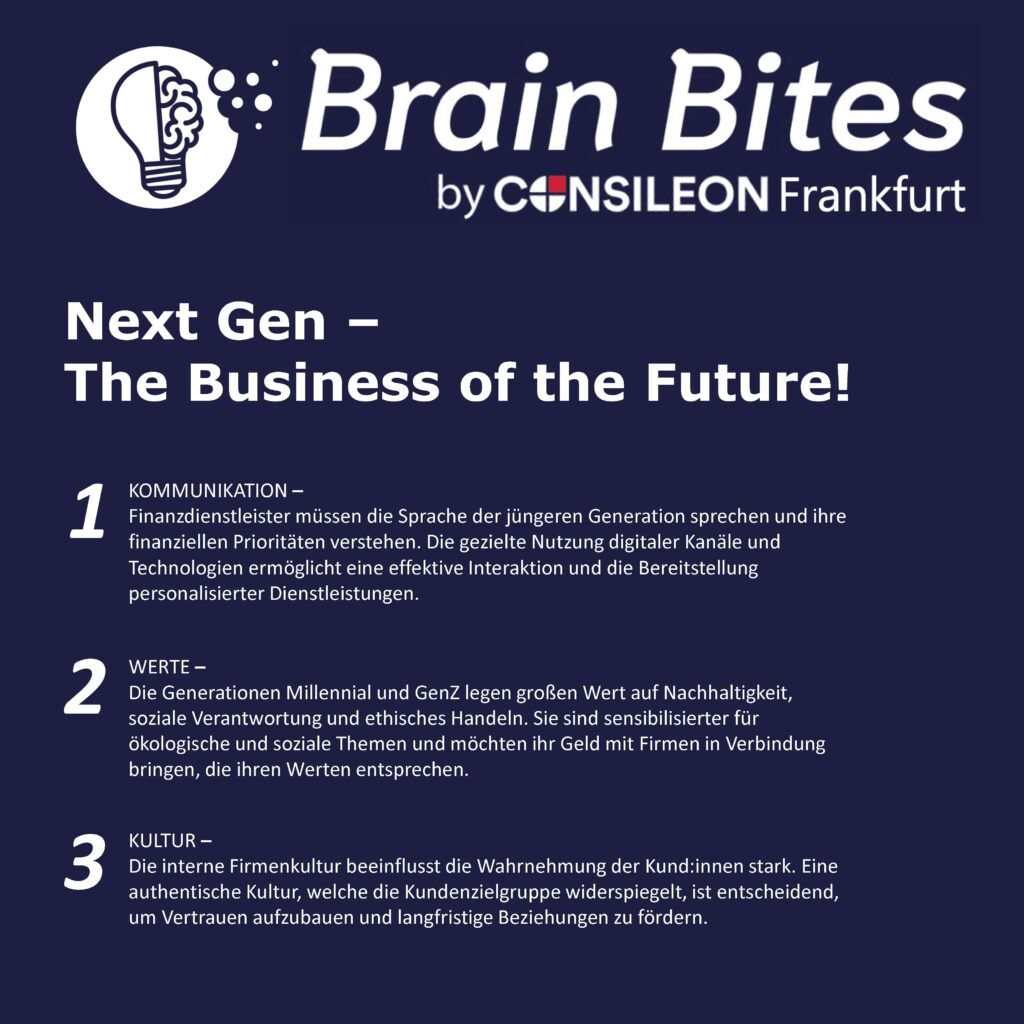Banks and the challenge of attracting and winning over younger generations
– A (r)evolution in banking is inevitable!
Banks need to be more attentive to current and future developments in the financial markets, given the ever-changing needs and preferences of clients, especially future generations of potential clients.
Basically, every bank must clearly communicate what its core motivation and mission is for the future. Potential customers, especially younger ones, ask themselves how a bank differentiates itself from its competitors, i.e. why their money is better off there than at other, competing institutions. This communication works most effectively through digital visibility on social media or a dedicated website, where this content can be explained simply and the most important values can be underlined. Innovation is needed to meet the demands of this new type of customer with different needs and values. This can only come about if internal structures are changed and diversified in advance. Diversity in organisational structures serves as a driver for change, as many different perspectives are incorporated into the development of new products and services. The composition of diverse teams and their mindset radiates outwards with regard to their integration in products and services and via customer communication, to which a sensitive clientele reacts quickly. Incorrect or insufficient targeting of certain groups (“biases” or “blind spots”) lead to a gradual exodus of those affected. To prevent this, optimal training of employees must be ensured so that such “blind spots” can be detected and addressed in time.
The rapid spread of information via social media means that incidents perceived as negative are punished directly and severely (e.g. through “shitstorms”), from which competitors benefit. For this reason, crisis management has a very high priority. Such potential crises must be clearly defined in advance for employees and backed up with options for action so that they can be recognised early and scandals can be avoided. If the emergency occurs and negative headlines spread quickly, the bank must have defined clear guidelines for damage minimisation and tested them in public communication. For many clients, the image of a financial institution is and remains of high importance, especially in a market environment that is seen by society as rather cool and purely profit-oriented. Protecting this important asset “image” in a targeted manner is therefore of central importance for future success.

Values such as sustainability, environmental protection, a sense of responsibility or human rights are very important to the younger generations. Failure to observe these values and the associated principles can quickly become a criterion for exclusion, e.g. for the GenZ. Accordingly, a clear positioning on these topics and the demonstrable promise to observe and comply with them is essential – especially with regard to the use of capital. The financial sector is one of the most important catalysts for our economy and decides into which sectors more resources will flow. This creates a responsibility to young people to counteract global problems such as climate change. Investing in visualisations of money flows and illustrations of the ultimate value and impact of client funds is a key tool in this regard to attract new capital. It often remains unclear whether one’s money really has the benefit that was promised and makes its desired contribution. In the future, abstract and complex systems must be described more simply and clearly in order to create more transparency. This creates trust, which in turn leads to the emotionalisation of products and services, generates new customers and also binds them in the long term. Combined with the public exchange in forums and discussion groups on online platforms, this trust is further strengthened. The greater tangibility and a more open, human exchange attracts younger generations. Financial houses must see themselves as lifelong learning organisms, constantly striving for improvement through a systematic analysis and reflection of their customer contacts. In the end, the companies that will be successful are those that focus more on their customers, respond more consistently to the needs of their target groups and align their actions with these needs.

Another aspect that is too rarely addressed in discussions around digitalisation in banking is the inclusion of older groups of people, such as the “best agers”. Not only younger customers need to be consistently addressed, but also the older, usually financially stronger generation needs to be retained by the banks by developing customised and target group-oriented offers for them. An example of this are readers that help older people with impaired vision to decipher small characters in contracts. Also, the familiar face-to-face meetings with bank advisors should not be abandoned and completely replaced by purely digital, more impersonal solutions, but should at least still be able to take place via virtual meetings. Excessive automation and digitalisation can be rather off-putting in this demographic group. However, it is important to also educate older client groups about the advantages of modern work and tools, to gradually introduce them to them and to train them.
Only a very small proportion of younger generations, e.g. GenZ, blindly trust their parents when choosing their bank or financial services provider. Banks therefore cannot rest on their past successes and must adapt their customer acquisition strategy. The younger generations, in contrast to the older generations, must be “played” much more frequently and in a more targeted manner. This central requirement to adapt the acquisition strategy is based on a shift in values, triggered by the target groups of the “next generations”, which will become increasingly important in the future. Banks have long been more than just financial institutions and are seen as a central pillar of our society. They are expected to help tackle the problems of tomorrow that many young people are concerned about. These include environmental protection, sustainability or upholding ethical behaviour. The greatest visibility for this is generated in social media. There, these issues are actively discussed and younger generations can better get to know and compare the banks and their specific stance on the respective issues. This increasing transparency is a great opportunity, but it requires interacting more openly and proactively with its target groups. This allows banks to learn more about the specific needs of younger generations and to address them in a more targeted way. By communicating a clear mission that addresses these needs, younger generations can be inspired and won over, but only if the fulfilment of this mission is proven in a sustainable way!




